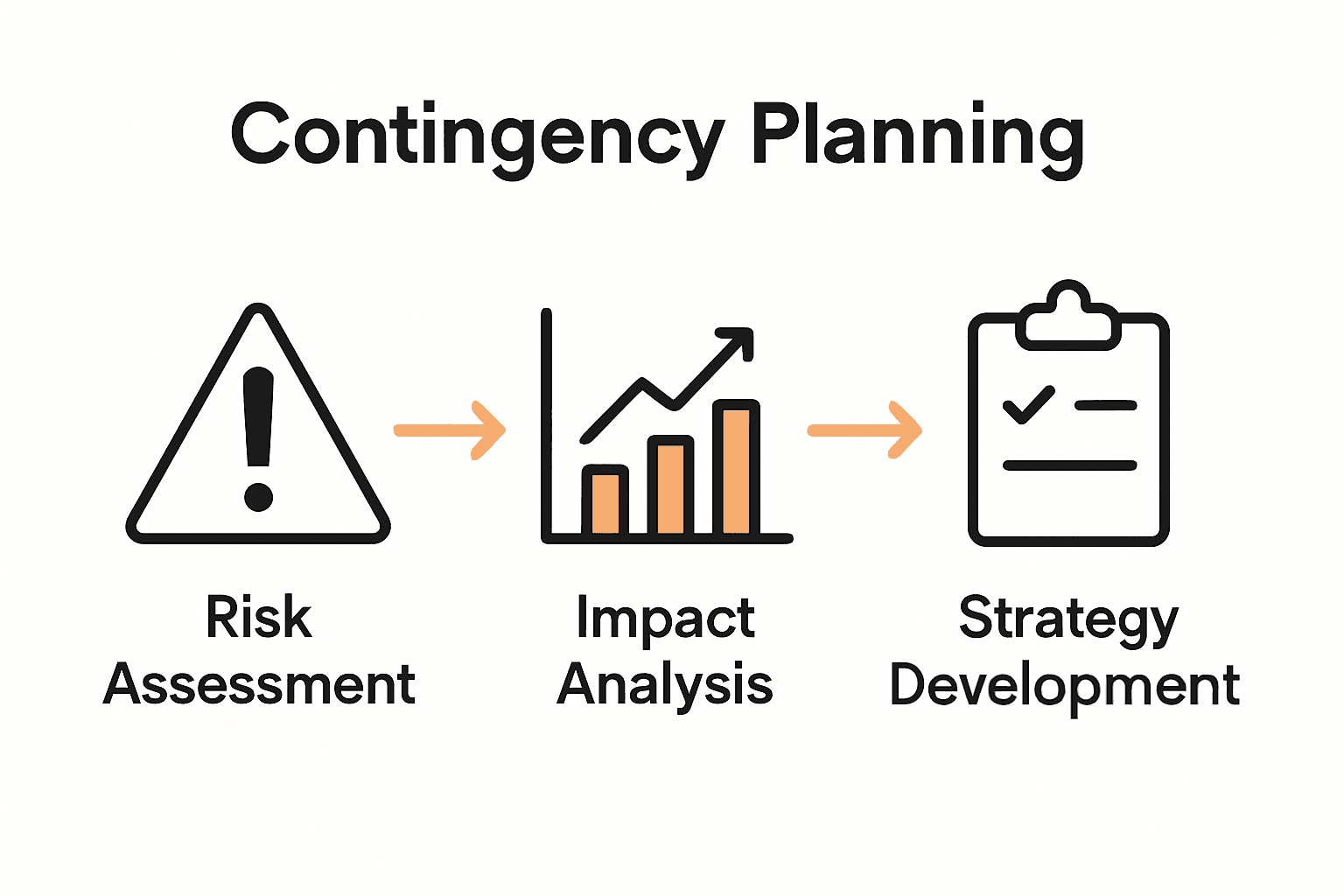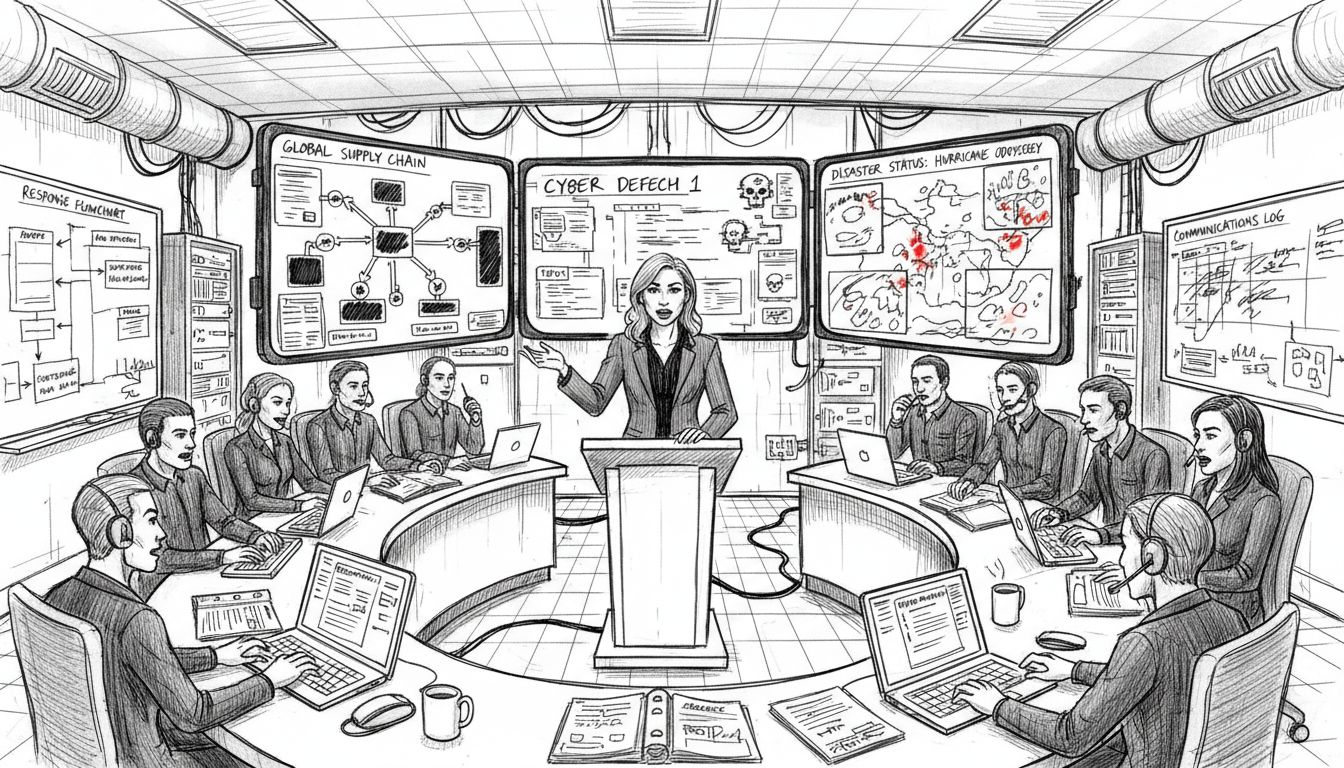Most american companies face unexpected disruptions every year and only a small fraction are fully prepared to handle them. Planning for the unexpected is not just smart business, it is a necessity in a climate where new risks can surface without warning. By understanding the fundamentals of contingency planning, organizations can avoid costly downtime and keep moving forward with confidence when challenges arise.
Table of Contents
- Contingency Planning Fundamentals And Core Concepts
- Key Types Of Contingency Plans In Business
- Essential Elements And Step-By-Step Process
- Roles, Responsibilities, And Team Involvement
- Implementation Best Practices And Common Pitfalls
Contingency Planning Fundamentals and Core Concepts
Contingency planning represents a strategic approach businesses use to prepare for potential disruptions and unexpected challenges. According to IBM, this process involves systematically identifying potential risks, developing responsive strategies, and creating comprehensive plans to ensure organizational resilience and continuity.
At its core, contingency planning requires businesses to conduct thorough risk assessments that evaluate potential threats across multiple dimensions. As highlighted by research from the Sage Publishers, these assessments must identify critical organizational functions and potential scenarios that could interrupt normal operations. Key elements typically include:
- Natural disaster scenarios
- Technology infrastructure failures
- Cybersecurity breaches
- Significant personnel transitions
- Economic market disruptions
Successful contingency planning goes beyond merely creating a document. It demands active engagement, regular testing, and continuous refinement of strategies. Businesses must develop actionable response protocols that can be quickly implemented when unexpected events occur. This means creating clear communication channels, defining specific team responsibilities, and establishing flexible decision making frameworks that allow rapid adaptation to changing circumstances.
The most effective contingency plans are living documents that evolve with an organization. They require periodic review, updating risk profiles, and simulating potential scenarios to test organizational readiness. By treating contingency planning as an ongoing strategic process rather than a static document, companies can build genuine organizational resilience that transforms potential vulnerabilities into opportunities for strategic growth and adaptation.
Key Types of Contingency Plans in Business
Businesses across industries develop contingency plans tailored to address specific organizational vulnerabilities and potential disruptions. According to Vaia, these plans can be categorized into several critical types that target unique operational risks and challenges.
As explained by 6Sigma, the primary types of contingency plans include:
- Business Continuity Plans: Focused on maintaining core operations during unexpected interruptions
- Cybersecurity Plans: Designed to protect digital infrastructure and respond to potential data breaches
- Financial Contingency Plans: Addressing potential economic disruptions and financial vulnerabilities
- Supply Chain Plans: Managing potential disruptions in product sourcing and distribution networks
- Natural Disaster Plans: Preparing for environmental events that could impact physical operations
Each contingency plan type requires a nuanced approach that considers the specific risks and potential scenarios unique to an organization’s industry and operational structure. For instance, a technology company might prioritize cybersecurity contingencies, while a manufacturing firm might emphasize supply chain and natural disaster preparedness.
The most effective contingency plans are not static documents but dynamic strategies that evolve with changing business landscapes. They demand regular review, scenario testing, and updates to remain relevant and effective. By developing comprehensive, adaptable contingency plans across multiple domains, organizations can transform potential risks into opportunities for strategic resilience and proactive management.
Essential Elements and Step-by-Step Process
Contingency planning requires a systematic and comprehensive approach to developing robust organizational resilience. According to IBM, the process involves carefully crafting strategies that can effectively address potential disruptions while maintaining critical business functions.
A step-by-step approach to developing a comprehensive contingency plan typically involves these critical stages:
- Risk Assessment
- Identify potential threats and vulnerabilities
- Evaluate potential impact on business operations
- Prioritize risks based on likelihood and severity
- Impact Analysis
- Determine critical business functions
- Assess potential financial and operational consequences
- Establish recovery time objectives
- Strategy Development
- Design specific response protocols
- Create detailed action plans for each identified risk
- Assign clear responsibilities to team members


As detailed by Webopedia, successful contingency planning demands more than just documentation. It requires active engagement, regular training, and continuous refinement of strategies. This means creating communication protocols, establishing decision making frameworks, and ensuring all team members understand their roles during potential disruptions.
The most effective contingency plans are dynamic living documents that evolve with organizational changes. They require periodic simulation exercises, stakeholder reviews, and updates to remain relevant. By treating contingency planning as an ongoing strategic process, businesses can transform potential vulnerabilities into opportunities for enhanced organizational resilience and adaptive capability.
Roles, Responsibilities, and Team Involvement
Team collaboration stands as the cornerstone of effective contingency planning, transforming theoretical strategies into actionable responses during critical moments. According to IBM, successful implementation depends on clearly defined roles and a coordinated approach that ensures every team member understands their specific responsibilities during potential disruptions.
A comprehensive contingency plan typically requires establishing key organizational roles:
- Crisis Management Team: Overall strategic decision makers
- Communication Coordinators: Responsible for internal and external messaging
- Technical Response Specialists: Address specific operational or technological challenges
- Financial Recovery Experts: Manage economic impact and resource allocation
- Operational Continuity Managers: Ensure core business functions remain operational
As highlighted by Vaia, effective team involvement goes beyond simply assigning titles. It requires regular training, scenario simulations, and creating a culture of proactive preparedness. Each team member must not only understand their specific role but also comprehend how their responsibilities interconnect with other team members during a potential crisis.
The most successful organizations treat contingency planning as a collaborative, dynamic process. This means conducting periodic workshops, cross-training team members, and creating flexible communication protocols that allow rapid adaptation. By fostering a culture of shared responsibility and continuous learning, businesses can develop resilient teams capable of navigating complex and unexpected challenges with confidence and strategic precision.
Implementation Best Practices and Common Pitfalls
Contingency plan implementation requires strategic precision and a proactive approach to organizational resilience. According to 6Sigma, successful deployment involves more than just creating documentation – it demands comprehensive testing, continuous refinement, and a deep understanding of potential organizational vulnerabilities.
Key best practices for effective contingency plan implementation include:
- Regular Scenario Testing: Conduct comprehensive simulations
- Comprehensive Training: Ensure all team members understand their roles
- Periodic Plan Reviews: Update strategies based on changing business landscapes
- Clear Communication Protocols: Establish transparent reporting mechanisms
- Flexible Response Frameworks: Design adaptable decision making processes
As explained by Webopedia, organizations frequently encounter several critical pitfalls during implementation. These common mistakes include inadequate risk assessment, insufficient stakeholder involvement, and failing to create truly adaptable strategies that can respond to complex, dynamic challenges.
The most successful contingency plans are living documents that evolve with organizational complexity. This means creating a culture of continuous learning, where team members are empowered to provide feedback, suggest improvements, and actively participate in scenario planning. By treating contingency planning as an ongoing strategic process rather than a static checklist, businesses can transform potential vulnerabilities into opportunities for enhanced organizational resilience and strategic adaptability.
Strengthen Your Contingency Planning with Smarter Team Management
Contingency planning demands detailed coordination and clear communication to transform risks into strategic opportunities. The challenges of managing multiple response protocols, assigning clear responsibilities, and adapting swiftly to change can overwhelm teams without the right tools. If you aim to build a dynamic, living contingency plan that evolves with your business needs, it is vital to leverage technology designed to reduce administrative burdens while enhancing collaboration.

Discover how Gammatica’s AI-driven platform empowers your team with task management, automation, and real-time collaboration to streamline your contingency plan execution. Free up to 16 hours per week by using AI suggestions and pre-made templates tailored for project and team management. Whether you need to coordinate crisis management teams or ensure flawless communication during disruptions, manage workflows effortlessly using Kanban boards, checklists, and integrated online meetings. Start building resilience today by visiting Gammatica.com and take control of your contingency planning before the next crisis hits.
Frequently Asked Questions
What is contingency planning?
Contingency planning is a strategic process that organizations use to prepare for potential disruptions by identifying risks and developing responsive strategies to ensure business continuity.
Why is risk assessment important in contingency planning?
Risk assessment is crucial as it helps organizations identify potential threats and vulnerabilities, evaluate their impact, and prioritize risks based on likelihood and severity, forming the foundation for developing effective contingency plans.
What are the key elements of an effective contingency plan?
Key elements of an effective contingency plan include risk assessments, impact analyses, strategy development, clear communication protocols, assigned responsibilities, and regular review and testing of the plan.
How often should contingency plans be reviewed and updated?
Contingency plans should be treated as living documents and reviewed periodically to ensure they remain relevant. Regular updates should reflect changes in organizational structure, risks, and operational procedures.


